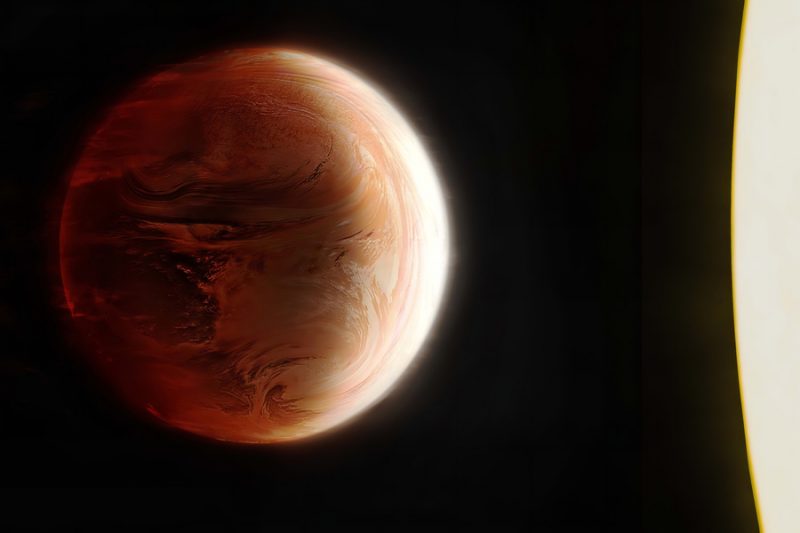
Astronomers have gotten their best view yet of the dark side of a giant exoplanet that orbits a distant star. The planet is called WASP-121b. It’s nearly twice the size of Jupiter. It’s tidally locked to its star, which means the same hemisphere of the planet continually faces the star. The astronomers said on February 21, 2022, that the hot Jupiter exoplanet probably has iron clouds, titanium rain and violent winds.
The scientists published their study in the peer-reviewed journal Nature Astronomy on February 21, 2022.
The study’s lead author, Thomas Mikal-Evans of MIT, commented:
We’re now moving beyond taking isolated snapshots of specific regions of exoplanet atmospheres, to study them as the 3D systems they truly are.
The 2022 lunar calendars are still available. Order yours before they’re gone!
The hot Jupiter exoplanet WASP-121b
Scientists originally discovered the hot Jupiter exoplanet WASP-121b in 2015. There’s much they’ve already learned about it. It lies 850 light-years away. It has one of the shortest orbits of a planet known, circling its home star in only 30 hours. It has water vapor in its atmosphere and temperatures that change with altitude. And remember it’s tidally locked: one side of the planet always faces its star. That side endures an everlasting day, while the other side of the planet experiences perpetual night.
A bizarre water cycle
In the new study, the scientists mapped temperatures on WASP-121b to see how they changed with altitude and from the day to night side. They were able to see water circulating in the thick atmosphere between the exoplanet’s day and night sides.
But the water cycle on WASP-121b is not like the water cycle on Earth. On Earth, water evaporates and rises where it condenses into clouds and then rains back down. On WASP-121b, the 3,000 kelvin (about 5,000 F or 2700 C) heat on the day side rips apart water molecules. Fierce winds then blow these remnants of molecules to the night side. In the cooler temperatures of the night side, hydrogen and oxygen can again combine to form water molecules. But the planet’s winds inevitably blow them back to the day side, where the cycle starts over.
The researchers calculated that the winds in the planet’s atmosphere roar at more than 11,000 miles per hour (5 kilometers per second). Another author of the study, Tansu Daylan of MIT, said:
These winds are much faster than our jet stream and can probably move clouds across the entire planet in about 20 hours.
Iron clouds and titanium rain on hot Jupiter dark side
And that’s not all. The atmosphere of WASP-121b only gets more interesting from there. Using computer modeling, the researchers were able to identify the chemicals most likely to be in the planet’s atmosphere. The models indicated metal clouds of iron, corundum and titanium on the night side. Corundum is the mineral that makes up rubies and sapphires.
These clouds, too, blow around the planet. As they blow from the night side to the day side, the higher temperatures vaporize the metals into gas. Rain in the form of liquid gems may even fall from the corundum clouds. Mikal-Evans said:
With this observation, we’re really getting a global view of an exoplanet’s meteorology.
Observing the planet’s dark side
The scientists examined WASP-121b using spectroscopic observations with the Hubble Space Telescope. To see the dark night side of the planet, they had to look for tiny changes in the planet’s entire spectrum as orbits its home star. Daylan said:
Hot Jupiters are famous for having very bright day sides, but the night side is a different beast. WASP-121b’s night side is about 10 times fainter than its day side.
The team studied WASP-121b through two orbits, one in 2018 and one in 2019. They looked for the absorption lines indicating water vapor. Mikal-Evans said:
We saw this water feature and mapped how it changed at different parts of the planet’s orbit. That encodes information about what the temperature of the planet’s atmosphere is doing as a function of altitude.
Temperatures and wind
With their observations, the researchers found that the planet’s day side is around 3,500 kelvin near the top of its atmosphere and a slightly cooler 2,500 kelvin (4,000 F or 2,200 C) at its deepest observable layer. The night side was 1,500 kelvin (2,200 F or 1,200 C) at the top of the atmosphere and 1,800 kelvin (2,800 F or 1,500 C) in its deepest observable layer. As you can see, the temperature flip flops from night to day side. The day side experiences what meteorologists call a thermal inversion, when cooler air is closer to the surface and capped by warmer air.
They also found that the hottest region of the planet is slightly east of the spot just below its home star. They believe this shift is due to the strong winds. Mikal-Evans said:
The gas gets heated up at the substellar point [where the star is directly overhead] but is getting blown eastward before it can reradiate to space.
Future plans for investigating WASP-121b
The team will be using the Hubble Space Telescope later this year to map carbon dioxide in the planet’s atmosphere. Mikal-Evans explained:
That would be the first time we could measure a carbon-bearing molecule in this planet’s atmosphere. The amount of carbon and oxygen in the atmosphere provides clues on where these kinds of planet form.
Bottom line: Scientists have revealed the dark side of a hot Jupiter exoplanet for the first time, finding iron clouds, titanium rain and violent winds.
Source: Diurnal variations in the stratosphere of the ultrahot giant exoplanet WASP-121b











